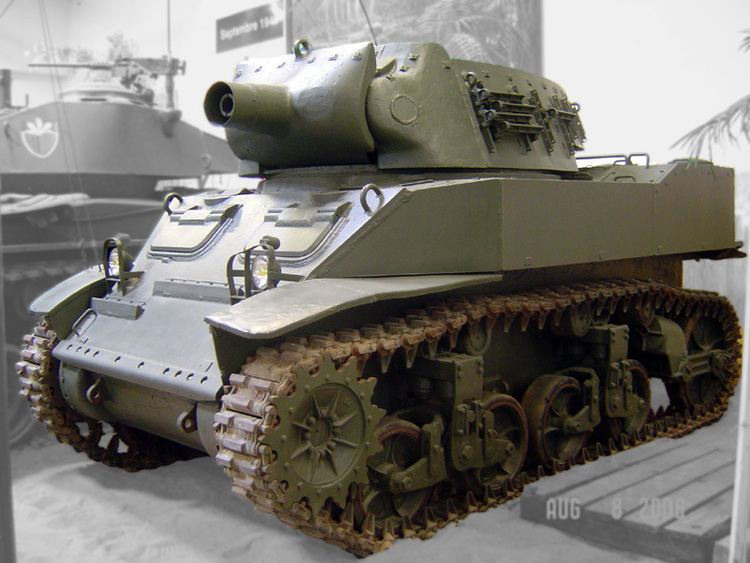Used by See Users | In service 1942-1960s Designed 1942 | |
 | ||
Designer U.S. Army Ordnance Department | ||
The 75 mm Howitzer Motor Carriage M8 was a self-propelled howitzer vehicle of the United States developed during World War II.
Contents
Development and design
The first design for a close support howitzer on an M5 tank chassis was the T41, which had the howitzer in the hull front. This did not progress past the mock-up stage as the crew would not have been sufficiently protected and design work started on the T47. It was developed on the chassis of the then-new Light Tank M5 (Stuart VI). The prototype was designated the 75 mm Howitzer Motor Carriage T17E1 It had the standard M5 turret removed and replaced with a larger open-topped turret; as a result, the drivers' hatches had to be moved from the hull roof to the glacis plate. After a mock-up had been produced, it was ordered into production as the 75 mm Howitzer Motor Carriage M8. The M8 was based upon the Light Tank M5, but incorporated several changes. Like the Light Tank M5, the M8 had a crew of four; commander, gunner, driver, and assistant driver/loader. When the M8 was in action, the commander positioned himself at the antiaircraft machine gun and directed his crew, the gunner sat in the turret on the right side of the howitzer, the assistant driver/loader moved up from his seat in the right front hull, and the driver stayed at his position.
Due to the usage of a new turret, the crew hatches in the hull roof for the driver and assistant driver/loader were deleted and replaced by a pair of vision flaps in the glacis. Since the glacis hatches were too small to disembark through, these two crew members had to leave the vehicle through the open-topped turret. The driver and assistant driver/loader were provided with periscopes for visibility. In November 1944, the Ordnance Department gave the M8 the name General Scott, after American general Winfield Scott.
Armor
As the M8 was based upon the Light Tank M5 (itself a descendant of the Light Tank M3) it had relatively thin armor. The lower hull armor ranged from 1 in (25 mm) to 1.125 in (28.6 mm) on the sides to 1.75 in (44 mm) on the lower front and 1.0 in (25 mm) on the lower rear. The lower hull sides were vertical, while the lower hull front was sloped at 18 degrees from the vertical, and the lower hull rear, which protected the engine and radiator, was sloped at 17 degrees from the vertical. The hull floor ranged from 0.5 in (13 mm) thick at the front to 0.375 in (9.5 mm) thick at the rear. The glacis plate of the M8 was sloped at 45 degrees from the vertical and was 1.125 in (28.6 mm) thick. The upper hull sides, like the lower hull sides, were vertical and 1.125 in (28.6 mm) thick at the front, thinning to 1 in (25 mm) thick at the rear. The upper rear hull was a vertical plate, 1 in (25 mm). The plate sloped at 50 degrees for a short distance before it met the hull roof, which was uniformly 0.5 in (13 mm) thick, and flat.
The turret of the M8 was of cast steel. It was 1.5 in (38 mm) thick at the front, which was rounded, sloping from 0 to 63 degrees from the vertical. The sides and rear were 1 in (25 mm) thick and sloped at 20 degrees from the vertical. The cast gun shield which covered the barrel of the 75 mm Howitzer M2/M3 was 1.5 in (38 mm) thick and rounded.
Armament
The armament of the M8 consisted of a new open-topped turret armed with a 75 mm M2 howitzer, later a 75 mm M3 howitzer. The M8 carried 46 rounds of 75 mm ammunition; 11 rounds at the right rear of the fighting compartment, 20 rounds at the left rear of the fighting compartment, 9 rounds in the left hull sponson, and 6 "ready" rounds stored between the driver and assistant driver's positions. The most common types of ammunition carried were the M89 white phosphorus shell and the M48 high explosive shell. Unlike the standard M5 light tank, the M8 featured no hull-mounted or coaxial Browning M1919A4 .30 caliber machine gun. A Browning M2HB .50 caliber machine gun with 400 rounds was mounted on the right rear corner of the turret for local defense and anti-aircraft purposes. For self-defense, the vehicle driver was provided with a Thompson submachine gun, while the other three crew members were issued M1 carbines.
Production
1,778 of the Howitzer Motor Carriage M8 were produced by the Cadillac division of General Motors from September 1942 to January 1944.
Combat service
The 75 mm Howitzer Motor Carriage M8 was assigned to the Assault Gun Troops of Cavalry Reconnaissance Squadrons in order to give them close support against enemy fortified positions. The high elevation (40 degrees) of the howitzer was useful for hitting enemies emplaced on the sides of hills. The M8 was used in the Italian Campaign, the Western Front, and in the Pacific Theater of Operations by the US Army and on the Western Front by the French Army. It was also used by the French Union and State of Vietnam during the First Indochina War. It stayed in French service until the 1960s and saw service in Algeria.
